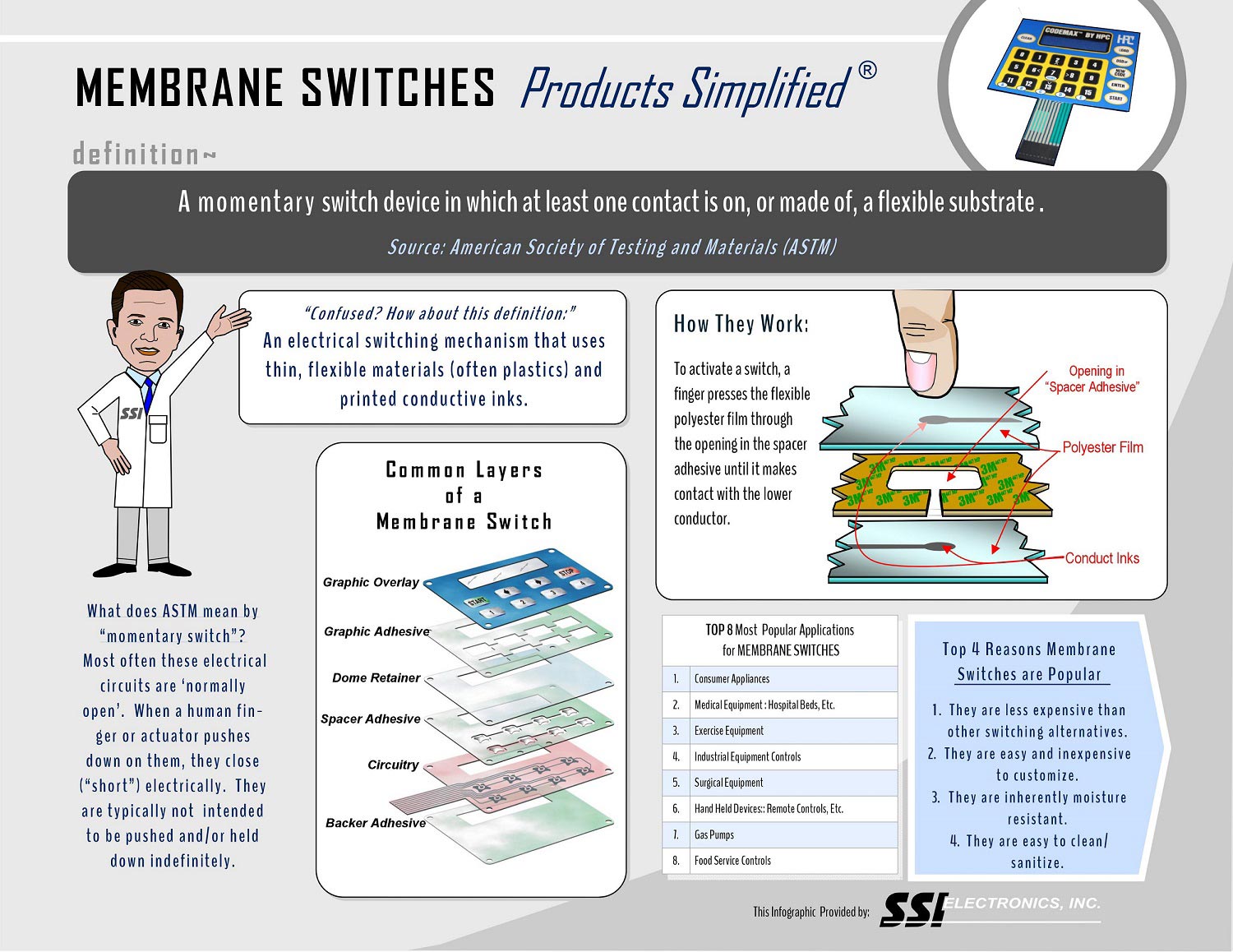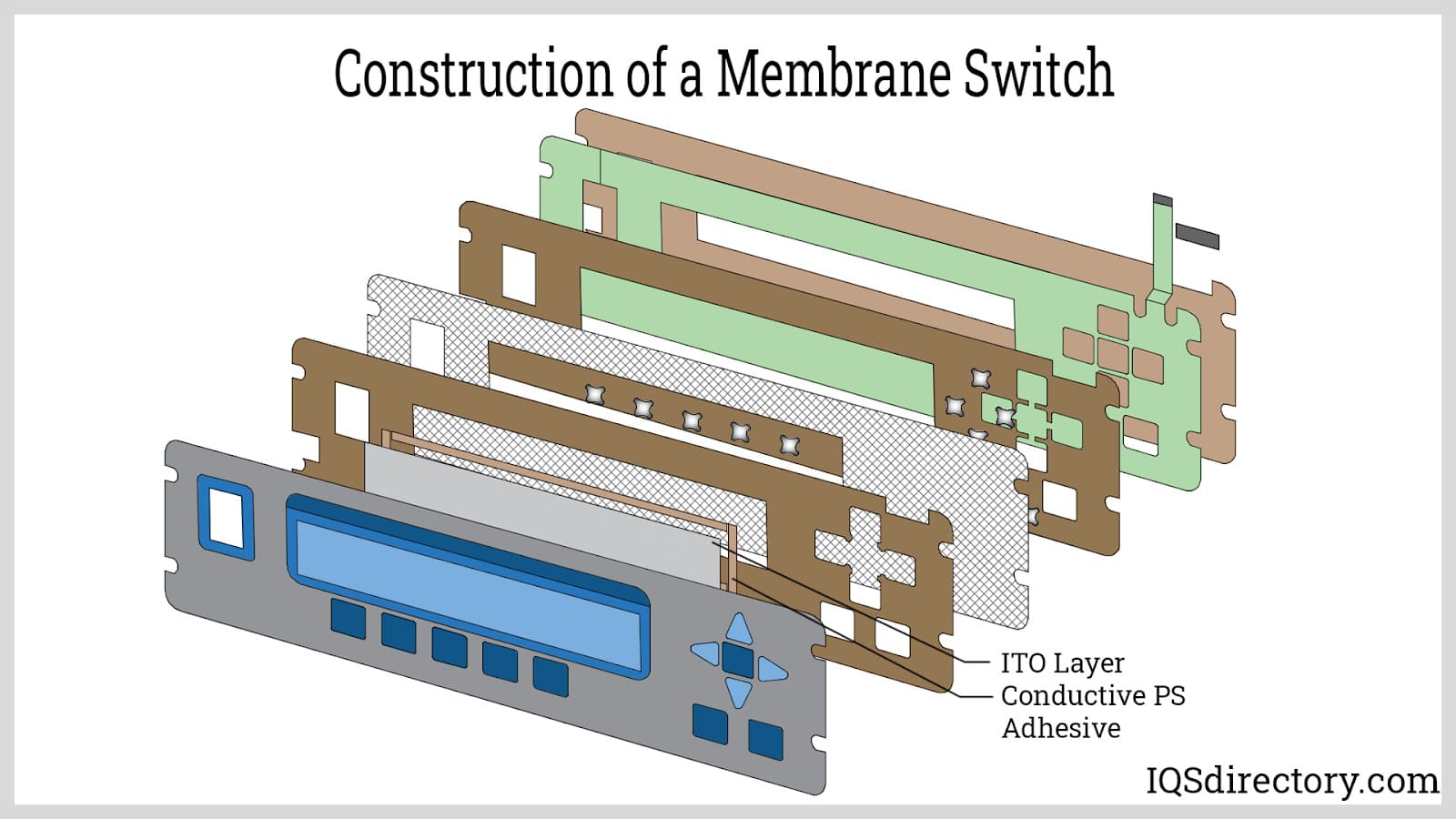The role of membrane switch in connected consumer appliances
Wiki Article
Recognizing the Importance of Membrane Switch Over in Modern Electronics
Membrane layer buttons are essential components in modern-day digital gadgets. They provide a blend of performance and layout that enhances individual communication. Their resilient and lightweight nature makes them ideal for different applications. As sectors progress, the demand for modification and progressed attributes expands. Recognizing exactly how membrane changes add to development discloses their value in forming the future of electronics. What exists ahead for this modern technology?The Fundamentals of Membrane Switch Modern Technology
Although typically neglected, membrane layer switch technology plays an important duty in the contemporary electronic devices landscape - membrane switch. These gadgets, made up of multiple layers, serve as customer interfaces for numerous electronic products, varying from house home appliances to medical tools. A common membrane switch contains a visuals overlay, a spacer layer, and a circuit layer, which are meticulously set up to produce a practical interface.When stress is put on the overlay, the circuit layer is completed, allowing signals to be transferred to the tool. This innovation is understood for its adaptability, enabling personalization in shape, capability, and style to satisfy certain customer demands. In addition, membrane switches are slim and lightweight, making them suitable for applications where area is a premium. Their toughness and resistance to environmental variables additionally boost their allure, ensuring they can hold up against harsh conditions while maintaining capability. Overall, membrane button technology is important to creating easy to use and reliable digital gadgets
Secret Advantages of Membrane Layer Switches
Membrane switches offer a number of vital benefits that make them a recommended option in various electronic applications. Their layout allows for a portable form factor, allowing makers to create sleek and lightweight tools. In addition, membrane switches are resistant to dust, dampness, and chemicals, which enhances their longevity and durability popular atmospheres. The tactile responses offered by these buttons can boost user experience, making them instinctive and easy to operate.Furthermore, membrane layer buttons can be tailored with varied graphics and colors, enabling distinct branding possibilities. The manufacturing process is usually cost-efficient, specifically for high-volume production, as it reduces setting up time and streamlines layout. Lastly, membrane changes require minimal maintenance, adding to reduced total operational prices. These benefits emphasize their growing appeal in modern-day electronics, where integrity and easy to use user interfaces are vital.
Applications Across Various Industries
The versatility of membrane layer switches over enables their extensive fostering throughout different markets. In the medical area, they are generally made use of in diagnostic tools and patient surveillance systems, using a sturdy user interface immune to pollutants. The auto industry utilizes membrane layer buttons for dashboard controls, enhancing individual experience with smooth designs that hold up against harsh problems. In customer electronic devices, they offer as control board for devices such as microwaves and coffee manufacturers, providing an easy to use user interface that is easy to tidy. The aerospace field utilizes membrane layer buttons in cockpit controls, where dependability and area effectiveness are vital. Additionally, the commercial sector leverages these switches in equipment and go to this web-site control systems to ensure durable operation sought after settings. This wide series of applications highlights the flexibility of membrane layer switches, making them integral parts in improving capability and customer communication throughout diverse technological landscapes.Personalization and Design Versatility

Future Patterns in Membrane Layer Switch Advancement
Arising trends in membrane layer switch growth suggest an expanding emphasis on improved functionality and integration with smart technologies. As customer demand for much more innovative digital devices rises, producers are concentrating on developing membrane layer switches that not just serve standard functional roles yet likewise include features like touch level of sensitivity, backlighting, and haptic feedback.Furthermore, developments in products are anticipated to boost durability and environmental resistance, making membrane switches appropriate for diverse applications in sectors such as healthcare, vehicle, and consumer electronic devices. The assimilation of capacitive touch modern technology is most likely to come to be a lot more prevalent, permitting sleeker layouts and improved user interfaces. membrane switch.Additionally, the rise of the Internet of Points (IoT) is prompting the advancement of membrane layer switches that can connect wirelessly with other devices, improving interconnectivity. On the whole, the future of membrane button innovation appears appealing, driven by technology and the quest of easy to use optionsRegularly Asked Inquiries
How Do Membrane Changes Compare to Traditional Mechanical Switches?
Membrane switches, being more space-efficient and supplying a smooth design, contrast with standard mechanical switches that give responsive comments. The previous commonly feature customizable graphics, while the last commonly assure resilience and dependability in different applications.What Products Are Generally Utilized in Membrane Layer Change Production?
Membrane switches are typically created utilizing materials such as polyester, polycarbonate, and printed conductive inks. These products provide durability, versatility, and responsiveness, making them suitable for numerous applications in digital gadgets and interface.Can Membrane Switches Be Fixed or Recycled?
Membrane layer buttons can frequently be repaired, particularly if small issues occur, such as adhesive failing or surface damages. Total reuse is usually restricted due to wear and possible deterioration of materials over time.
How Do Environmental Variables Impact Membrane Switch Performance?
Ecological elements, such as direct exposure, temperature, and humidity to chemicals, considerably affect membrane layer button performance. Extreme problems can result in degradation, impacting responsiveness and durability, inevitably endangering the capability of the device in various applications.What Is the Regular Life-span of a Membrane Layer Switch over?
The common lifespan of a membrane layer button typically varies from 1 to 5 million actuations, depending upon elements such as usage regularity, environmental problems, and the products utilized in manufacturing, impacting durability and efficiency longevity. A common membrane layer switch is composed of a visuals overlay, a spacer layer, and a circuit layer, which are thoroughly put together to develop a functional interface - membrane switch.When stress is applied to the overlay, the circuit layer is finished, allowing signals to be sent to the gadget. The responsive feedback supplied by these switches can improve user experience, making them intuitive and easy to operate.Furthermore, membrane buttons can be customized with diverse graphics and shades, permitting for distinct branding opportunities. As consumer demand for extra innovative digital devices rises, suppliers are concentrating on developing membrane layer changes that not only serve standard functional functions yet also Your Domain Name include attributes like touch sensitivity, backlighting, and haptic feedback.Furthermore, advancements in materials are expected to enhance toughness and ecological resistance, making membrane changes appropriate for diverse applications in industries such as healthcare, auto, and consumer electronic devices. The integration of capacitive touch innovation is most likely to end up being extra widespread, enabling for sleeker layouts and boosted user interfaces.Additionally, the surge of the Internet of Things (IoT) is motivating the development of membrane switches that can connect wirelessly with other gadgets, boosting interconnectivity. Membrane switches, being more space-efficient and offering a streamlined layout, comparison with typical mechanical switches that give tactile commentsReport this wiki page